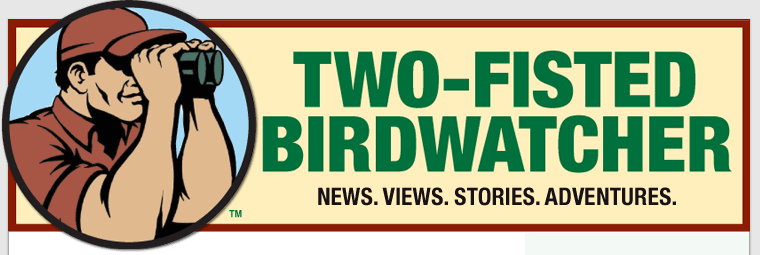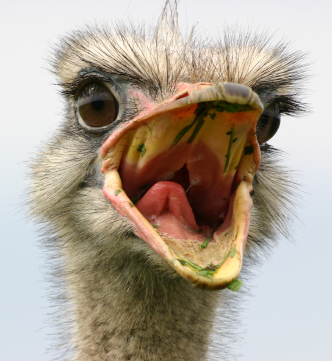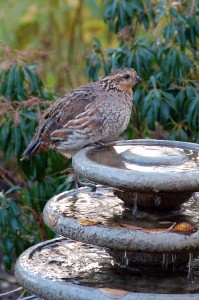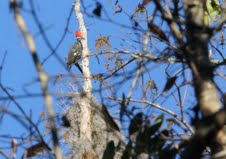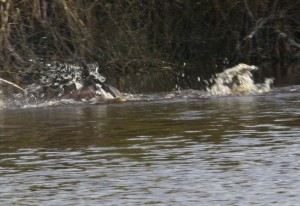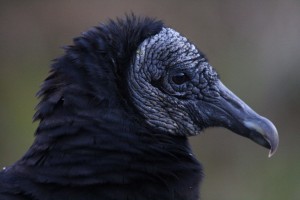You might’ve noticed. We have this “Hidden Bird Contest.” Our first two hidden birds, a Red-eyed Vireo and a Black Skimmer, were found by visitors to our site and these people had their names put into a drawing, blah, blah…anyway two winners got sweatshirts. You can read about this contest on our “Hidden Bird Contest” page. Now there’s a third bird that’s hidden. I wish I didn’t know where it was. People tell me it can be fun to go birding on this website. Like hunting around in the outdoors for a rare bird, but without leaving your keyboard. This hidden bird is the Painted Bunting. An improbably colorful male with patches of hot red, blue, green and purple. Probably the most colorful bird in America, maybe the world. To announce the new hidden bird contest we found a photo of an eyeball with these colors reflected in it. Sheer luck. Then we discover that this bird has been hidden in a place (sorry, can’t say where. It’d spoil the fun) that lines it up next to this photo. So it looks like the eye is reflecting the bird. Brilliant…but utterly unintended. If you haven’t found the Bunting yet, I guess we just gave you a bit of a clue, but not too much of a clue. You’ve still got a labyrinth of sorts to explore before your eye gets all colorful like that.
The story of the colorful eye.
November 14th, 2009What did I see? Can anybody help?
November 11th, 2009This happened a week ago. Whatever I saw, it’s gone now. I’ve been back. It hasn’t. But I keep wondering what it was. Here are the facts. I was walking through a meadow of knee-high dead grass. In the distance there are woods with mostly bare trees. It’s early November. Gray and cool. I saw a flock of starlings, some juncos, un-migrating robins, nothing special. A crow flew overhead, far away. There was a blue jay in one of the trees. They used to be more common, but West Nile decimated their population in our area a few years ago. Nice to see a blue jay, always. As I moved further on the trail I saw a flock of cedar waxwings in a small tree. They’re drab and don’t look like bird-book waxwings at first, but give them a second look and you’ll see the crest and slight coloring. Then I saw a bird I couldn’t place. It looked like a sparrow or possibly a big, late, fall warbler. It had a bit of yellow on its side. Don’t get excited, I know a siskin when I see one. This wasn’t. It also had orange on its face, and a black cap. The beak wasn’t fat or thin. It flew in a jerky pattern and landed on a weed not far from where it started. Orange-red on the sides of its face, maybe some white, too, and a black cap; yellow markings on the side. I don’t know. Maybe it’s a siskin that flew through a paintball war or something. In any case, it’s long gone. But what was it? Anybody have any ideas?
Something wild.
November 9th, 2009My sighting today was wild. Right out of a nature documentary. In the weeds to my right I saw something brownish moving. I thought maybe it was a coyote or fox. Then big wings adjusted themselves, forming a tent-like shape. A large Red-Tailed Hawk was on top of something, covering it.
(When the full moon is overhead, it looks small and when it’s on the horizon it looks huge. This is a famous optical illusion. The same thing applies to hawks. On the ground, the bird was massive; looking way bigger than it does when circling above.)
As I watched, its wide wings opened, extended, and scooped air under them, raising the heavy bird up and out of there, pure muscle and big-feather power. A small animal dangled from the hawk’s beak, moving, still alive. I think it was a field mouse. It had a long thin tail.
The hawk flew to a tree. I figured that within the cover of branches, the bird would tear its prey into quickly swallowed chunks. Then it would sit and digest. Or maybe it would resume the hunt. The hawk was big and the mouse was small.
An interesting sighting. But it didn’t happen in the woods or open prairie. It happened in the roadside foliage next to my car as I waited for a red light near stores, traffic and lots of concrete. That was the really wild thing about it.
You know the truth, right?
November 6th, 2009Today, this gray, early November day, I went into the woods and where trees meet an overgrown meadow, I saw a Lazuli Bunting. Blue on top, white and orange in front. Sitting in a bush. Huh. A Lazuli Bunting. Now that’s something to report.
But the truth is…..c’mon, you know the truth, right?…..it wasn’t a Lazuli Bunting. It was an Eastern Bluebird. A late hanger-on, since cold’s coming and the Bluebirds head south around now. (Although I’ve seen a few over the winter, in recent years). So why’d I call it a Lazuli Bunting?
Once, a few months ago, I heard a guy in a bird club talking about a Lazuli Bunting in that meadow. I worked my way over there, alone, and all I saw was an Eastern Bluebird. But I couldn’t really blame the guy. Look in a bird book or on a bird website. It’s an honest mistake. Forget, for the moment, that the Lazuli Bunting’s a western bird, and that it’s skinnier, and that it’s got wing bars. Forget all that and imagine you see it on a bush, and you’ve got a book that groups blue colored birds, and you get excited. Hey, Lazuli Bunting, tell everyone. Yeah—probably not.
So when I see an Eastern Bluebird in this old familiar meadow I say, hmmm, the Bunting’s back. My private joke. But sometimes I think—what if the joke’s on me? Could that bird club guy have been right? What if his bird was a thousand miles out of its range? What if it happened to be sitting where our Eastern Bluebirds sit? What if it really was a Lazuli Bunting? And what if it stays around sometimes, this lost western bird, well into November. What if? Anyway, I saw it today.
It’s reliable. Whatever you call it.
November 5th, 2009People ask: do you really go in the woods every day? Will you report what you see there? Is this blog like the one we saw in that movie about the woman who cooked a different recipe every day and reported on it? Is it like the body builder’s blog that describes his routines every day and let’s you watch his muscles grow? Is it like that? People ask: Are you going to give us a vicarious bird sighting every day? Answer: I’m going to try. Then they say: okay, what did you see today? Answer: a Dark-eyed Junco. But I call it a Slate-colored Junco. That’s what it was called before taxonomists clarified, revised, updated and improved the naming of this bird. There’s enough room in the woods for people to use whatever names they like. (Even when we were told to call our Baltimore Orioles “Northern Orioles,” a while back, I ignored the name change. Good thing: they changed it back!) Anyway, that’s what I saw today. A Junco. You might ask: One lousy bird? Why bother telling us? Well, no. I saw others. But this is the daily sighting I enjoyed most. This little winter visitor reminds me that the seasons are changing, will change, have always changed. It’s reliable. I like that about the Junco, Dark-eyed or Slate colored.
My neighborhood: A bird-eat-bird world
November 4th, 2009There’s a bird hawk in my neighborhood. It keeps an eye on the feeders. It keeps an eye on me. When I look at it, it takes off and flies low through the trees without hitting anything. From its viewpoint, the terrain must look like something out of a Star Wars space battle. The bird hawk zooms over, under and around branches with no problem.
The problem belongs to the other birds. They’re food on the wing for the bird hawk. It’ll take them out of the air as they fly. Or it’ll come up behind them as they sit near a feeder. And they’ll be gone without a peep.
It’s a bird-eat-bird world, and the bird hawk doesn’t care about much else. It certainly doesn’t care about what we call it, taxonomically speaking. Yeah, you’ve probably been wondering why a two-fisted bird watcher has been using a vague term like “bird hawk.” Well, it’s a good term. Descriptive and fail safe.
See, this is probably a Sharp-Shinned Hawk. How it got that name is another avian-naming curiosity. It doesn’t sit still long enough for you look at its shins, and who knows what sharp ones would look like anyway? But it might be a Cooper’s Hawk.
You knew that, right? It’s one or the other. Sharp-Shinned or Cooper’s. I’m not sure which, though, and make no apologies. These two hawks are notoriously hard to tell apart. (My gut tells me Sharp-Shinned, and there are weak field markings to support this, but nothing conclusive.) The Cornell Lab of Ornithology even has a page on their website dedicated to figuring out the differences between these two hawks.
But why bother. It’s a bird hawk and it lives around here. It doesn’t know the name we call it. It doesn’t know my name, either, although it does know that I make it nervous when I stare, so it takes off. But it never goes far. We’ll cross paths again, probably tomorrow, this bird hawk and I. Whatever it’s called.
Sometimes a sighting can save your life.
November 2nd, 2009This didn’t happen today in the woods. But I thought about it today in the woods. I always think about it. It happened in a suburban forest near a river basin one rainy spring. I’d seen American Redstarts, Green Herons, Wood Ducks, nothing too unusual, but colorful. There was a Northern Waterthrush, Ovenbird, and I’d heard a Belted Kingfisher up river. I stopped to look up at some Red-Headed Woodpeckers, one male and some brown-headed juveniles. The river seemed loud but I paid no attention. I moved a step, and the noise increased. I still paid no attention. Then my heel slipped into a depression. I caught my balance and looked down. Whoa: the noise I’d been hearing was coming from a storm sewer opening. Its lid had been removed and sat in the weeds, rusty and heavy-looking. I stared into the hole. A round-walled shaft, wide enough to swallow a person. At the bottom, ten feet down, was a current of racing, splashing water. It moved from a hole on one side and shot into a hole on the other side. Anything that dropped in would be carried away. I was standing on the lip of this thing. I backed away. But for a bit of luck, I’d have dropped in while looking up at woodpeckers. On hitting bottom, I’d have been swept into a tunnel of water. Drowned, and nobody’d know. I wrestled the rusted manhole cover onto its side, rolled it over and let it drop into position, sealing the hole. I left the woods. I’d seen some colorful birds and didn’t get swept away. Two good things. Now I try to keep ground-aware as I walk in the woods. Maybe you will too, okay?
Halloween sighting. Might’ve been a ghost.
October 31st, 2009I saw a Turkey Vulture on Halloween. I don’t know if it was heading south. Vultures will hang around our area well into winter, at least that’s been my observation. Migration, for a lot of birds these days—herons, for example—doesn’t seem to be the hard-wired obligation it once was. I watched the vulture wheeling around up there and thought of a deceased writer who said he’d like to come back as one of these birds. The writer was Ed Abbey. He wrote the somewhat famous “Desert Solitaire” and other books that are fun because the guy was a curmudgeon. (Sounds like a kind of duck, you know? Curmudgeon). And he had a way of appreciating wild things. For example, he didn’t mind sharing his trailer with a rattlesnake when he lived in the desert. Many people would say they’d want to come back as something more glamorous than a bald, carrion-eating bird. But when you think about it, the Turkey Vulture has a good life. It soars on wide wings all day. It sees well, and when it finds something to eat, it doesn’t have to inflict panic or pain; the prey’s already dead. The vulture just plunges in, digests with pleasure and helps clean up the place. Then it’s another day in the sky, above it all, enjoying the scenery. If a Turkey Vulture ever thought of re-incarnation I doubt he’d want to come back as a writer. I think he’d want to come back as another vulture. Keep a good thing going. There are a lot of Turkey Vultures, and I see one or two every week. If I’m driving I slide my sunroof open so I can look up at the bird. I think: is that the ghost of Abbey up there? I may not remember everything the guy wrote, but I can’t forget his choice of re-incarnation.
A shocking sighting. No, two shocking sightings.
October 30th, 2009I’ve walked through prairies before. I knew that pheasants and other birds of the quail persuasion hunker down until you get close, then fly up into your face, shocking you. I knew this. But it happened anyway. I was making my way through knee-high weeds and BAM, a burst of flapping wings. It was a Ring-Necked Pheasant shooting up and flying away. Before I could calm down, it happened again: ANOTHER big bird flapped out of the same spot in the weeds, shocking me again. But it was no pheasant; it was a Red-Tailed Hawk. The pheasant went left and the hawk went right. Suddenly it was quiet. At my feet there was a scatter of soft feathers and red, shining blood. I guess the hawk was on the pheasant and just digging in when I came along. The pheasant seemed okay; its flight was strong and it disappeared into the distance. The hawk went to a nearby treetop and glowered at me. Tough birds, both of them. I figured I’d helped the pheasant. Then I realized I’d interfered with the hawk’s meal. What was I? Rescuer, or pain in the butt? Neither. I was just another agent of chance.
A daily observation that wasn’t in the day.
October 29th, 2009I was walking my dog near midnight. In the top of a leafless old tree, way up, I saw the unmistakable silhouette of a Great Horned Owl, black against a black sky. I rushed home and came back with a portable searchlight. I shined my light on the owl, getting a good look. It was huge, with brown streaks and had tufts on its head that looked like horns. Its round yellow eyes glared down at me. I thought the bird might take off. Then I remembered reading somewhere that unexpected bright light could cause an owl’s wide-open eyes to lose night vision for a moment, so I clicked it off. The owl had work to do. Owls sometimes eat skunks, and our dog had been skunked earlier in the year. I figured maybe this owl would grab a skunk if it saw one. We needed its vision to be in good shape. I said, “Sorry about the light, bub.” And went home.
Report of the day: “Snow Robins.”
October 28th, 2009I try to go into the wild every day, if only for a short time. I live in a wooded area with a pond out back. There are hardwood forests, scrubby fields and a river nearby with beaver sign—gnaw marks and wood chips. I usually see something interesting. I’ll let you know, right here. Sometimes I might go on a tangent (see last two posts) and rant about some other subject. But we’ll do the daily reporting most of the time. Today I saw a flock of Robins. Now there’s nothing rare about Robins; they’re common. But I always think it’s unusual that they don’t migrate any more. They used to, when I was a kid. By November they’d be gone. Now they congregate in great numbers, especially in the woods. I never realized they were social until I saw this. I’ve seen them in deepest winter. Snow Robins, we call them. And their plumage is paler. Last winter’s surprising stay-over bird was a Great Blue Heron that I saw walking on ice. Another example of gradual climate change, I guess. Tomorrow I’ll look for the little Pied Billed Grebe that turns up on our pond from time to time during migrations, and I’ll let you know what I see.
Where’d the Bobolinks go?
October 27th, 2009The year’s almost over and I realize that once again I haven’t seen a Bobolink. In fact, I haven’t seen Bobolinks in years. My spot for Bobolinks was an unspoiled short grass prairie. These birds, with their distinctive warbling calls would hover and circle over their territories. And you could see them hanging onto the sides of weed stalks, black-chested birds in Spring with that unexpected yellow-white nape coloration. Pretty cool. But the powers that be—including well-intentioned nature lovers—decided to turn the wild prairie into a botanic garden. Now it’s just another tamed and sculpted piece of land. It’s nice to look at, with planted gardens, exotic trees and tram rides. And there are some birds hanging around. But no Bobolinks. They’ve bobbed on out of there.
Not seen in the wild? It doesn’t count in my book…
October 26th, 2009Birds observed at feeders don’t really count. Sorry. Bison seen crossing a road in Yellowstone don’t count. Lions in a Kenyan “game preserve” don’t quite count. You want them to count, but they don’t. They have the taint of the zoo on them. You know this in your gut, right? The Red-Bellied Woodpecker hammering on a dead tree in a wild river valley is spectacular. When it’s eating suet that you put outside your kitchen window it’s like a pet. Or am I missing something?
Pigeons, Gulls and Dumb Luck
October 18th, 2009You’re enjoying an Orlando vacation, lazing at a lakefront resort. Taking a break from everything, even bird watching. But you don’t really need a break from this effortless hobby. In fact, it has saved many a vacation.
There was one interminable European trip that you survived by walking through parks near the cathedrals and museums that your wife and others in your group felt compelled to visit. You said: seen one crumbling statue, seen ‘em all. This opinion wasn’t popular with your companions.
On the other hand, the Europeans do have a whole other birdbook to explore, living things you don’t get to see in the U.S.A. Like Wagtails, little European Robins, Green Woodpeckers and Blue Tits; even their Jackdaw crows are interesting with two-tone gray and black coloration. But that was Europe, this is Florida.
Meanwhile, back at the beach…
You’re enjoying the sun. Doing nothing. Thinking nothing. There are birds around but none is unusual. Just pigeons who find the garbage cans interesting, and of course there are gulls near the water. Probably Herring Gulls and Laughing Gulls, but you’re not looking closely. You’re on vacation.
Then a thought hits.
You wonder: what do the pigeons think of the gulls? The pigeons are wobbly and pear shaped, short winged, grayish and comparatively clumsy. While the gulls are sleek and slender, long winged and regal. They make flying a sport. Pigeons do it to get from here to there. Gulls do it to swoop and sail, the kind of thing you’d do if you could fly, if you had wings.
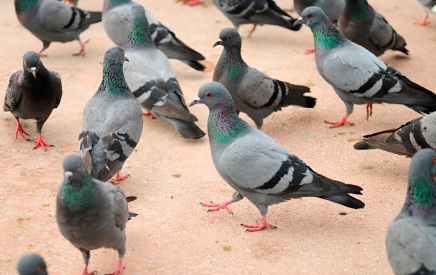
Who could help but admire the gulls and their grace? Do the pigeons admire them? And what do the gulls think of the pigeons? Do they see them as chubby nerd birds who can’t rise to the heights of the cool kids? You have to figure: probably.
You try to imagine that you’re a gull.
You’d fly just for the fun of it. You’d coast on the wind and dip and slide over the water, and then rise and circle, do a wing-over stunt or two, and it would feel great. The pigeons and featherless humans are just pathetic background. Gulls are royalty of the shore, made to fly, and nobody does it better.
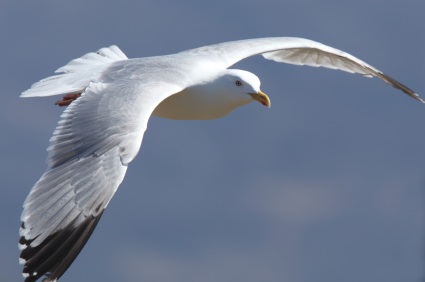
Hey, if you were a pigeon you’d want to become a gull. You’d go on a diet. You’d watch how gulls fly and try to emulate them. You’d see how long you could hover without having to flap. But the sad truth is that if you didn’t flap, you’d drop. And if you didn’t eat you wouldn’t get slim; you’d get weak and maybe die. You were put in a pigeon body and that’s the end of it.
Idle musing, not worth disturbing the pleasures of sun and relaxation. But then a new thought hits. It’s related to the irrevocable destiny of pigeons and gulls. And it’s right in front of your eyes…
There’s a boat rental business by the shore.
It’s a family resort and boats are being offered to kids and parents, miniature motorboats, big enough for one teenager or maybe a dad and his seven-year old. These little boats zoom around the lake. Each is shaped like a speedboat, but smaller.
Kids line up to get in as boats come back from their half-hour rental. Riders who are returning exit onto the pier, and an attendant pushes the empty boat into position for a new passenger or two to get in.
It’s fun to watch this.
But you notice something. Some boats are faster than others. An eager kid gets into the boat he was given and throttles it forward, full blast. But his boat doesn’t have pep. It’s a pig; it groans rather than roars. Its wake is anemic and its nose doesn’t rise as high as the noses of other boats. That’s the luck of the draw.
A different kid gets into the next boat, and it’s a charged up maniac of a little speedboat. It zooms past the pig boat, hitting waves with loud slaps that you can feel in your chest.
What was that all about? Each kid was more or less equal. Same age and size. Both were aggressive fun lovers. But one got assigned a boat that was sluggish, and the other got a better one. The kids had nothing to do with it. It was fate, destiny, dumb luck.
And you think: Hey, some birds got put into pigeon bodies. There was nothing they could do about that. And some got put into gull bodies. Just luck.
Same thing happens to people.
Some of us get put into average-looking bodies while others get pro athlete’s bodies, or super-model bodies. It’s the way of the world, the way of all life.
So what do you do? If you’re a pigeon you walk around in that goofy, neck-bobbing style and hope somebody throws bird seed on the ground near you. And if you’re a gull you fly on the wind. You enjoy it. And you better be thankful that things worked out that way.
Okay, enough thinking. C’mon, this is your vacation. Why not settle back, read a summertime book, get some sun, take a nap. You realize that you’re better off at work. When you get too much leisure, your mind works overtime. You try to blank out your thoughts. Simply listen to the waves and enjoy the breeze.
Then a gull flies over and you can’t help saying to yourself: lucky, just lucky.

Something Interesting: Guaranteed.
September 6th, 2009You went for a hike this morning figuring something interesting would happen. It always does. Guraranteed. We’ll get to that later.

This morning you saw one of your favorite birds, a male Yellow-Shafted Flicker. Same woodpecker that’s mentioned in The Boy Detective. But even if you hadn’t seen the Flicker you’d have seen something else. Maybe another favorite, the Scarlet Tanager. Since summer’s nearly over, this bird’s changing plumage would be mottled with green. Interesting.
Maybe you’d see a bird you never saw before. Once you met an old man in the woods. He was an odd bird: elfin and friendly, bent over and looking for medicinal herbs. He told you his name was Huckleberry Finn. You thought he was crazy, but he showed you his driver’s license. His last name was truly Finn. The nickname was what his friends called him.

On a dawn hike you saw a giant, big-chested deer with sprawling, pointed antlers and you felt a little uneasy. He outweighed you, big-time, and he looked aggressive. Interesting.
Once you followed laughter coming from a woodland brook and saw a couple skinny dipping. Oops. You crept away quickly. But it was interesting.
Once you saw a red fox cross your trail. You saw a snake but couldn’t identify the make and model, just that it was colied, shining and primeval, with a darting forked tongue and no fear.
Once you went for a hike in the woods and saw nothing special. No interesting birds. The trail was quiet. No other people, no snakes, foxes, nothing. You just hiked for an hour or so, then left. That was unusual, seeing nothing noteworthy. Then it hit you: Hey, that was the interesting thing. Something interesting had happened after all. It never fails.
Baseball and Sudden Death
August 23rd, 2009Baseball. Sudden death. Two-fisted subjects. But what are they doing on a website about birds and birding? Everything.
By now you’ve probably seen the snippet of video in which fireballer Randy Johnson throws a 97-mile-an-hour pitch in a Diamondbacks-Giants pre-season game, and a bird happens to fly into the trajectory of the ball as it zooms from the mound toward the plate. Bam, the bird explodes in a burst of feathers while stunned ballplayers stop the game and the umps try to figure out what to call the pitch.
Makes you wonder two things: One, if you’re interested in birds—and you probably are, otherwise you wouldn’t be reading this website—what species was that hapless bird? Well, as far as we can tell it was one of those show biz albino Rock Doves, although some say a gull. We’ll call it a dove, though, since gulls are less likely in Arizona, and there was talk of a dove-releasing ceremony at the game. In any case, it was an explosion of white, and it sure wasn’t a Snowy Owl.
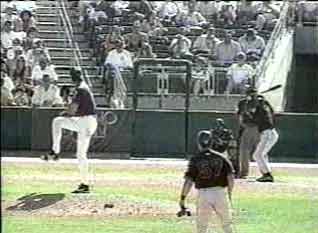
- The windup…
By the way there’s actually different footage of another bird being hit, same way, in a minor league game. That bird was documented as a gull, probably a Herring Gull and it was said to have survived. Gulls are tougher than doves. And a minor league pitcher’s no Randy Johnson. If you’re going to get smacked by a league, stick to the minors.
Anyway, the other thing you’ve got to wonder is: Life, what’s it all about. One second you’re flying along without a care and the next second you’re a splatter of feathers and a hit on You Tube.

- The pitch
Now, the more philosophical of two-fisted guys are saying, hey, maybe that’s not so bad. Think of all the things this bird will never have to do…
It’ll never have to sit around starving because its arthritis is so bad it can’t fly. It’ll never die of cancer of the giblets. It’ll never perch on a branch wondering where the hell it is and how did it get there. It’ll never look at a hot young Rock Dove and think, “I haven’t got a chance.” It’ll never get old and lose its feathers.
Was it good to die young? No, absolutely not. Was it good to die fast? Well, sure. Was it good to be immortalized by Randy Johnson, one of the biggest, hardest-throwing pitchers to ever head for the Hall of Fame?

- “Splat!”
From our point of view, the human, or at least semi-human view, we have to say that it’s humbling and instructive, even inspirational, to be reminded once again how everyday life can disappear in a splash.

- A little more okay
You don’t expect it. You can’t see it coming. And bam, gone. Thoughts like this can make you feel like getting a big martini and a steak. And while you’re in the mood, it just seems a little more okay to get the pie ala mode for dessert.
Why not enjoy the things you were born to enjoy? They say you never hear the shot that kills you. If you’re a dove on a baseball diamond, you never see the fastball that gets you. And if you’re a guy, you might never know when the good times are going to stop rolling.
So enjoy. And take solace in knowing that the bird nailed by Randy Johnson probably had a belly full of ballpark fries and a half eaten hotdog, two tastes of bird heaven, with more to follow. At least we hope so.
Three Guys
August 16th, 2009Three guys in different places and points of time. They never knew each other. And didn’t have much in common. Well, one thing. But that’s the punch line, and we’ll save it…
Gene.
Gene managed a carnival. The guys who worked for him had tattoos, missing teeth and great stories. Military adventures, run-ins with cops, road trips. They were on familiar terms with strippers. And liked whatever beer was on sale.

Serious as war
Gene had been in Viet Nam. His eyes were squinty. His hair was grayish and neat. He had a faded tattoo on his forearm. It was a large forearm, and the tattoo looked serious as war.
He had a young second wife, purely trailer park. Tight pants, painted nails and a pack of cigarettes in her fist. One afternoon, during a storm, we gathered in the concession stand eating hotdogs, listening to Gene’s wife rant about a guy who bothered her. You never heard a woman talk so profane. She said Gene punched the guy out.

I broke it
Gene had two grown sons who worked there. One was a body builder with long hair. He only talked about weight training. The other was lanky and going bald. He said motorcycle helmets caused his hair to fall out. He was always mad about something and talked about going into bars to pick fights.
Both sons would stop talking when Gene came around. One hot night, I broke the Ferris wheel. Forgot to lock one of the baskets and it splattered neon tubes, then jammed. I froze. Gene appeared out of the darkness and took charge. He fixed the wheel quickly, got the riders out and patted my shoulder. He said, “Forget it, kid.”
Tex
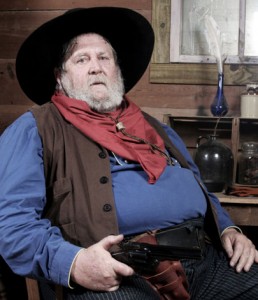
A cowboy in a rank cowboy hat
Tex was old. His legs were bent. His nails looked like they came from elephants. He wheezed, and his belly hung over his jeans. He was a cowboy in a rank cowboy hat. He lived in a world of horse manure. It was ground into him. It didn’t make him smell bad; he smelled like a stable. We knew Tex through vague family connections when I was twelve. We’d rent horses from him.
He’d sit on a crate in the stable, and when he got up you could see he was bow-legged like Yosemite Sam. We’d shake hands and his skin felt like animal hide.
Tex had been a rodeo rider and wrangler. He drank redeye and slept outside. Everyone knew that he’d rescued a rider on a runaway years ago by galloping to the horse and jumping on its head, slowing it, saving the day.
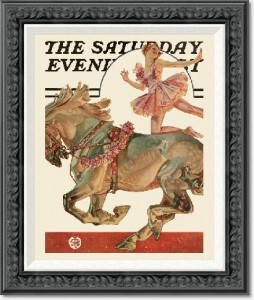
She'd stand on a horse
He married a cowgirl and had a little cowgirl child who grew up to be a bareback rider. In her act she’d stand on a horse like a ballerina. Tex had an old magazine cover with a picture of her on it. He nailed it to the wall in a dusty office. Nearby there was a gunbelt, holster and old Colt .45.
Tex died. We didn’t go to his funeral and never went to the stable again. At the time I thought of his bow legs having trouble fitting into any coffin. A private joke that I wasn’t proud of.
Al
Al had a reputation as a motorcycle racer. He kept a shiny Harley under a tarp in the gas station where I worked at eighteen. I was a grease monkey, changing oil, doing brake jobs, fixing flats. My fingernails wouldn’t wash clean that year.

Sometimes you have to do something even if it can't be done
One afternoon I was working by myself. The place smelled of gas and rubber. I was eating peanuts, hoping nobody’d come in. Bored, I opened the drawers in Al’s old desk. I found photos of him at motorcycle races holding trophies.
Later that week we worked on a car that needed a wheel pulled, a stubborn chunk of rust. I learned that sometimes you have to do something, even if it can’t be done. All the guys tried to remove this wheel. We poured solvents. We heated it, cooled it. Nothing worked.
After we gave up, Al took charge. He got a mallet and kept hitting the wheel. It wouldn’t move and he kept hitting. No talk. He hit the wheel while some of us watched and others drifted away. He hit it forever. He could still be hitting it.
But the thing is, he hit it until it started to move. Then he hit it until it came free. And he went to the cooler for a beer. We all had beers.
Okay.
What did these three guys have in common? You might be thinking: they were take-charge types. Gene fixing the carnival ride, Tex stopping a runaway horse, Al hammering a stuck wheel until it moved. Well, that’s one thing. But not what stands out the most.
Here it is: They all had a specific knowledge of wildlife that was surprising for such guys. They weren’t bird watchers in the traditional sense. But they knew what they saw; they knew what was out there in the world, and they knew it by name.

Not a buzzard
The tattooed veteran with the profane wife once said there was a Barn Swallow’s nest in the ticket stand. The old cowboy didn’t call a Turkey Vulture a buzzard; he called it a Turkey Vulture. The mechanic liked to walk near a pond in Michigan where he said there were Black Terns, a fairly uncommon bird.
Talk about uncommon birds. Gene, Tex and Al. They weren’t the type to join clubs. But they had life lists in their heads. Tex said he’d seen a California Condor out West when they were still wild. Al talked about a “snake bird” in a Louisiana bayou, correctly calling it an Anhinga.
A footnote: Why isn’t this piece of writing in our “Stories” category? It reads like three little stories, with characters who seem a bit larger than life. And there’s a story-like point to the whole thing. Well, the reason that it’s in our non-fiction “Viewpoints” category is that it’s all true. Those three guys really existed and were just the way you see them described here.
